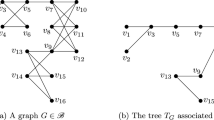Abstract
The hyper-torus network based on a three-dimensional hypercube was introduced recently. The hyper-torus \(QT(m,n)\) performs better than mesh type networks with a similar number of nodes in terms of the network cost. In this paper, we prove that if \(n\) is even, the bisection width of \(QT(m,n)\) is \(6n\), whereas it is \(6n+2\) if it is odd. Second, we show that \(QT(m,n)\) contains a Hamiltonian cycle. In addition, its one-to-all and all-to-all broadcasting algorithms are introduced. All of these broadcasting algorithms are asymptotically optimal.










Similar content being viewed by others
References
Seo JH, Lee HO, Jang MS (2008) Petersen-torus networks for multicomputer systems. In: Proceedings of the 4th international conference on networked computing and advanced, information management, pp 567–571
Dally W, Seitz C (1986) The torus routing chip. Distrib Comput 1:187–196
Stojmenovic I (1997) Honeycomb network: topological properties and communication algorithms. IEEE Trans Parallel Distrib Syst 8(10):1036–1042
Tang KW, Padubidri SA (1994) Diagonal and toroidal mesh networks. IEEE Trans Comput 43(7):815–826
Chen MS, Shin KG (1990) Addressing, routing, and broadcasting in hexagonal mesh multiprocessors. IEEE Trans Comput 39(1):10–18
Vaidya AS, Rao PS, Shankar SR (1993) A class of hypercube-like networks, Proceedings of the 5th IEEE symposium on parallel and distributed processing, Dallas, Dec, pp 800–803
Yeh CH, Varvarigos EA, Parhami B (1999) Efficient VLSI layouts of hypercubic networks. In: Proceedings of the 7th symposium on the frontiers of massively parallel computation, Feb., pp 98–105
Ki WS, Lee HO, Oh JC (2009) The new torus network design based on 3-dimensional hypercube. In: Proceedings of the 11th international conference on advanced communication technology, pp 615–620
Bornstein CF, Litman A, Maggs BM, Sitaraman RK, Yatzkar T (2001) On the bisection width and expansion of butterfly networks. Theory Comput Syst 34:491–518
Hsu Lh, Lin CK (2008) Graph theory and interconnection networks. CRC Press, Boca Raton
Díaz J, Serna MJ, Wormald MC (2007) Bounds on the bisection width for random \(d\)-regular graphs. Theo Comput Sci 382:120–130
Garey MR, Johnson DS (1979) Computers and intractability, a guide to the theory of NP-completeness, Freeman, San Francisco
Monien B, Preis R (2006) Upper bounds on the bisection width of 3- and 4-regular graphs. J Discrete Algorithms 4:475–498
Stacho L, Vrt’o I (1998) Bisection width of transposition graphs. Discrete Appl Math 84(1–3):221–235
Tang KW, Kamoua R (2007) An upper bound for the bisection width of a diagonal mesh. IEEE Trans Comput 56(3):429–431
Zdeborová L, Boettcher S (2010) A conjecture on the maximum cut and bisection width in random regular graphs. J Stat Mech Theory Exp 2010:1–12
Rahman MS, Kaykobad M (2005) On Hamiltonian cycles and Hamiltonian paths. Inf Process Lett 94(1):37–41
Wang D (2001) Embedding Hamiltonian cycles into folded hypercubes with faulty links. J Parallel Distrib Comput 61(4):545–564
Albader B, Bose B, Flahive M (2012) Efficient communication algorithms in hexagonal mesh interconnection networks. IEEE Trans Parallel Distrib Syst 23(1):69–77
Farah RN, Othman M (2014) Broadcasting communication in high degree modified chordal rings networks. Appl Math Inf Sci 8(1):229–233
Ho CT, Johnsson L (1986) Distributed routing algorithms for broadcasting and personalized communication in hypercubes. In: Proceedings of international conference on Parallel Processing, pp 640–648
Johnson SL, Ho CT (1989) Optimal broadcasting and personalized communication in hypercubes. IEEE Trans Comput 38(9):1249–1268
Stewart IA (2014) Interconnection networks of degree three obtained by pruning two-dimensional tori. IEEE Trans Comput (to appear)
Thomson A, Zhou S (2014) Frobenius circulant graphs of valency six, Eisenstein–Jacobi networks, and hexagonal meshes. Eur J Comb 38:61–78
Acknowledgments
We thank the reviewers for their comments and suggestions which have substantially improved our presentation. This research was supported by Basic Science research program through the National research Foundation of KOREA (NRF) funded by the Ministry of Education, Science and Technology (2012R1A1A4A01014439).
Author information
Authors and Affiliations
Corresponding author
Rights and permissions
About this article
Cite this article
Kim, JS., Kim, S.W., Qiu, K. et al. Some properties and algorithms for the hyper-torus network. J Supercomput 69, 121–138 (2014). https://doi.org/10.1007/s11227-014-1130-0
Published:
Issue Date:
DOI: https://doi.org/10.1007/s11227-014-1130-0




